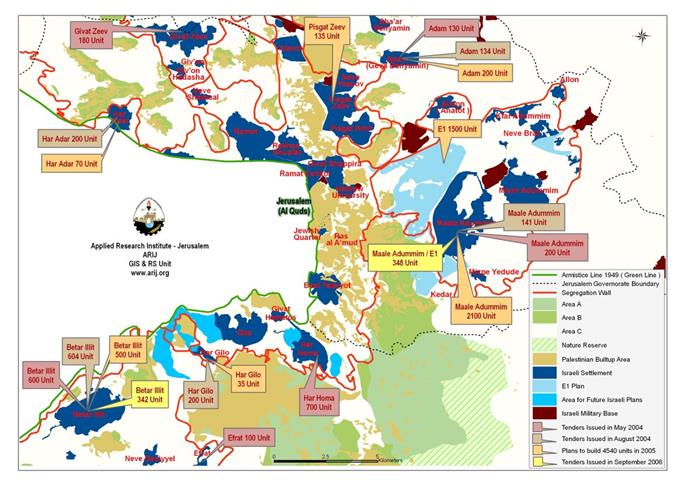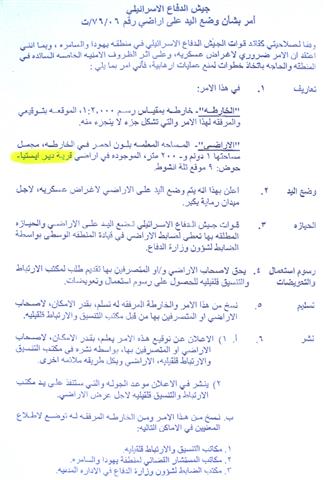Even-though the consecutive Israeli governments were well aware that settlements establishment and expansion stands as a greave breach and violation of international law and the agreements signed with their Palestinian counterpart, they still encouraged and support the settlements program in the occupied West Bank territory over decades of Israeli occupation. Moreover and contrary to what the consecutive Israeli governments claim, the settlements’ expansion in the West Bank, were at no time about natural Growth but only a pretext to consolidate Israeli control over the occupied Palestinian territory.
On September 21, 2006, the Israeli Ministry of Housing and Construction issued tenders to construct 164 new housing units in 3 Israeli settlements in the West Bank. The tenders included 88 housing units in Ariel settlement near Salft city, 56 housing units in Alfei Menashe settlement southeast of Qalqilyia city and 20 housing units in Karnei Shomron settlement south of Kafr Laqif village in Qalqilyia Governorate. The new tenders of the housing units have one thing in common; they are all located within the Ariel settlements bloc; inside the Segregation Wall, north of the West Bank.
Since the Israeli elections in March 2006, the Olmert government has issued tenders for 788 new housing units in Israeli settlements in the West Bank; excluding the September 164 housing units, which brings the total number of tenders issued to date to 952 new housing units. The bulk of tenders issued for new housing units took place in September (854 new housing units) right at the time when Israel ended its aggression on Lebanon under the pretext of retrieving the captured soldiers.
Since January 2006, Israel has issued tenders and announced plans to increase housing units in Israeli settlements in the West Bank. Below is a descending chronology of the tenders and plans issued or declared from the beginning of this year.
-
September 21, 2006, the Israeli Ministry of Housing and Construction issued tenders to construct 164 new housing units in 3 Israeli settlements in the West Bank (88 housing units in Ariel settlement, 56 housing units in Alfei Menashe settlement and 20 housing units in Karnei Shomron settlement).
-
September 4, 2006, the Israeli ministry of construction and housing issued tenders, to construct 690 new housing units in the settlements of Betar Illit in Bethlehem Governorate (342 housing units) and Ma'ale Adumim in Jerusalem (348 units housing units).
-
On June 13, 2006, The Israeli land Authority announced plan to construct 54 new housing units in Elkana settlement near Ariel bloc on 54 parcels of land.
-
On May 27, 2006, The Israeli committee for planning and construction announced about new plans to construct two new neighborhoods in Ramat Shlomo neighborhood containing 1960 new housing units on 597 dunums of land of Shu'fat city.
-
On January 2006, The Israeli authorities announced the plans to construct 5000 new housing units in the settlements of Betar 'Illit in Bethlehem (2000 housing units), Efrat in Bethlehem (750), Ma'ale Adumim in Jerusalem (500), Zufim in Qalqiliya (450) and Ariel in Salfit (350) during the current year – 2006.
Map of Israeli Tenders for new housing units during the years 2004, 2005 & 2006
The new tenders of housing units to Israeli settlements indicates that Israel will not compromise on the evacuation od these settlements in the future, it also indicates that these settlements are likely to expand more in area to accommodate the settlers that will be evacuated later on from settlements that were not annexed by the Segregation Wall. Furthermore, the new tenders also intent to send a message to right wing parties that Kadima government under Olmert administration will not abandon the settlement program, which might provide Kadima government with a safety net from early elections called by many Israeli parties.
The myth of 'natural growth” of Israeli settlers'' population
The average annual increaseof population inside Israel ranges from 1.6-1.8% and for West Bank settlements it ranges from 2.7-3.5%, except that the average increase of settlers numbers living in settlements located west of the Segregation Wall is much higher. In fact, the Israeli tenders issued clearly indicate a pattern of intensive construction in settlements located between the Segregation Wall and the 1949 Armistice Line (the Green Line) in an area called the “seam zone”, which indicates that the Israeli government is anticipating an increase of settlers population inside those “seam zone” settlements once evacuation process of isolated settlements near Palestinian communities is evacuated. Alfei Menashe, Ariel and Karnei Shomron settlements are of the total 99 “seam zone” settlements that will witness the bulk of all atypical expansion process in the future and unnatural growth in population.
1- Alfei Menashe Settlement: located southeast of Qalqilyia City, about 5 kilometers from the 1949 Armistice Line (Green Line). The settlement was established in 1981 on an area of 2905 dunums of lands originally owned by the nearby Palestinian Village. It is bordered by the villages of Habla and Ras 'Atyie from the west and southwest respectively, An Nabi Elias Village from the north and Qalqilyia city from the northwest. By the end of 2005, the settlement’s population was 5500 Israeli settlers. According to Graph 1 below, Alfei Menashe settlement experienced an average 8% annual increase in population from the time it was established.
Graph 1
Source: Israeli Central Bureau of Statistics
2- Ariel Settlement is located to the north of Salfit city, 16.1 kilometers from the 1949 Armistice Line (Green Line) and is part of the Ariel Settlements Bloc. It was established in 1978 on lands originally confiscated from the villages of ——-. Today, the settlement stands on an area of 5185 dunums and houses a total population of 16400 Israeli Settlers. Graph 2 below details the increase of settlement's population throughout the years of 1982 and 2006.
Graph 2
Source: Israeli Central Bureau of Statistics
3- Karnei Shomron Settlement is located to the south of Kafr Laqif Settlement, 9 kilometers away from the 1949 Armistice Line (Green Line). It was established on lands of —– in 1978. Today Karnei Shomron Settlement sets on an area of —- dunums of land and accommodates more than 6200 Israeli settlers. Graph 3 below, shows the population growth of Karnei Shomron settlement throughout the period of 1982 and 2006
Graph 3
Source: Israeli Central Bureau of Statistics
Expansion of Israeli Settlements and international Law
The ongoing Israeli activities in the Israeli settlements are blatant infringement to all signed agreements between the Israelis state and the Palestinian side, as well as to International Law and human Rights Laws, beginning from the Illegal confiscation of Palestinians' lands and properties, the expansion of Israeli settlements through outposts and addition of housing units, and the various Israeli procedures used to enforce settlements' existence in the Palestinian Territory.
-
The Fourth Geneva Convention prohibits the occupying power to transfer citizens from its own territory to the occupied territory (Article 49).
-
The Hague Regulations which prohibit the occupying power to undertake permanent changes in the occupied area, unless these are due to military needs in the narrow sense of the term, or unless they are undertaken for the benefit of the local population.
Prepared by
The Applied Research Institute – Jerusalem
ARIJ


















